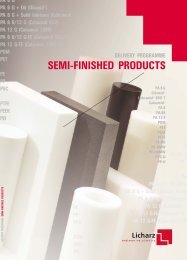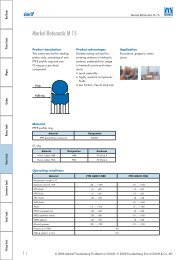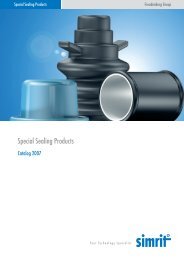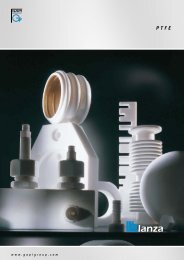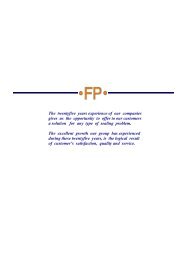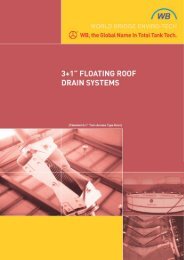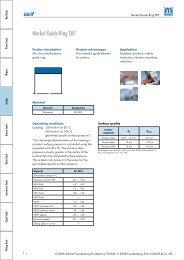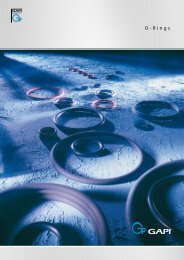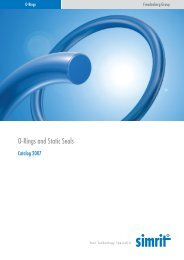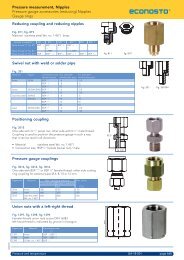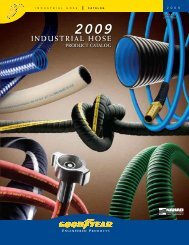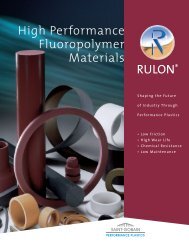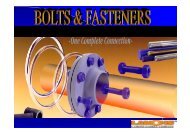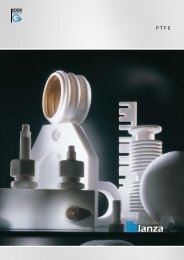Oleodinamica/Pneumatica Hydraulic/ Pneumatic
Oleodinamica/Pneumatica Hydraulic/ Pneumatic
Oleodinamica/Pneumatica Hydraulic/ Pneumatic
Create successful ePaper yourself
Turn your PDF publications into a flip-book with our unique Google optimized e-Paper software.
ISA<br />
FASCE DI GuIDA PER STELO TIPO ISA<br />
Descrizione<br />
Per evitare il contatto diretto tra lo stelo e la testata<br />
del cilindro, e tra il pistone e la camicia, che nella<br />
maggior parte dei cilindri pneumatici è di alluminio,<br />
si inserisce una fascia di guida tipo ISA che serve per<br />
tenere guidato tutto il sistema.<br />
Le fasce di guida sono stampate con un materiale<br />
auto lubrificante, non abrasivo, studiato<br />
appositamente per favorire uno scorrimento lineare.<br />
Il profilo della guida presenta smussi sia all’interno<br />
sia all’esterno che facilitano il montaggio dello stelo<br />
e del pistone.<br />
Limiti d’impiego<br />
Velocità: < 1 m/s<br />
Temperatura: da - 40° C a + 115° C<br />
Carico statico: fino a 36 N/mm 2<br />
Materiale<br />
Poliacetalica modificata.<br />
Grazie all’aggiunta di particolari additivi si è<br />
realizzato un materiale molto scorrevole e non<br />
abrasivo.<br />
Codice materiale standard: R3<br />
Vantaggi<br />
– Ottimo rapporto prezzo/prestazioni<br />
– Basso effetto stick-slip<br />
− Buona resistenza alla compressione<br />
<strong>Oleodinamica</strong> & <strong><strong>Pneumatic</strong>a</strong><br />
ROD SLyDRInGS TyPE ISA<br />
Description<br />
Given that most pneumatic cylinders are made of<br />
aluminium, a wear ring ISA is inserted between the<br />
piston and the bore in order to prevent the direct<br />
contact between the rod and the cylinder’s head.<br />
The function of the friction ring is to guide all the<br />
packing.<br />
The wear rings are moulded in non-abrasive autolubricating<br />
material, which has been purpose<br />
designed to support linear sliding.<br />
The wear ring profile has chamfers both inside and<br />
outside to facilitate the installation of the rod and<br />
the piston.<br />
Technical data<br />
Speed: < 1 m/s<br />
Temperature: from - 40° C up to + 115° C<br />
Static Strength: up to 36 N/mm 2<br />
Material<br />
Polyacetalic resin.<br />
Through the use of additional compounds a very<br />
slick, anti-friction material has been developed.<br />
Standard compound reference: R3<br />
Advantages<br />
– Excellent price/performance ratio<br />
– Low stick-slip effect<br />
− Good compressive strength



